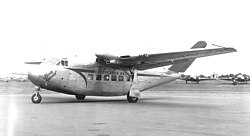Beechcraft 34 twin quad
| Beechcraft 34 twin quad | |
|---|---|

|
|
| Type: | Feeder aircraft |
| Design country: | |
| Manufacturer: | |
| First flight: |
October 1, 1947 |
| Commissioning: |
not in series |
| Production time: |
1947 |
| Number of pieces: |
1 |
The Beechcraft 34 Twin-Quad was a feeder aircraft from the American manufacturer Beechcraft , which made its first flight in 1947. The all-metal shoulder - decker with nose wheel landing gear could carry up to 20 passengers. However, this largest aircraft from Beechcraft was not ready for series production.
On the one hand, the design of the drive, in which four piston engines acted on two propellers, so that the machine looked like a twin-engine airplane on a cursory glance, was on the other hand the V-tail, which was rather uncommon at the time .
history
After the end of the Second World War, Beechcraft saw a market opportunity for an economically operated feeder aircraft that could also be used from unpaved runways .
At the end of 1946, the development was intensified with the testing of the engine transmission. The prototype with the aircraft registration number NX90521 completed its maiden flight on October 1, 1947 from the Beech Factory Airport in Wichita (Kansas) . From October 1947 onwards, around 200 hours of intensive testing were completed in over 100 test flights.
On January 17, 1949, there was an emergency landing shortly after taking off from the works airfield in Wichita. The copilot was killed, the captain and two engineers survived injured. 1) The prototype was irreparably damaged.
1) According to another source, two crew members died in the accident.
The calculated performance data, such as a top speed of 480 km / h, could not be achieved in the test phase. The accident of the prototype also had the effect of deterring potential customers from buying. In addition to a model for static test purposes, the construction of a second flying model had started but was no longer completed. The loss from this project was $ 6 million.
construction
An almost rectangular all-metal hull without a pressurized cabin was designed for the shoulder- wing aircraft. The fuselage keel was reinforced in order to minimize the forces on the planking of the fuselage structure in the event of a belly landing , which actually succeeded in an unplanned fall; there was only minor damage.
The landing gear consisted of an electrically retractable nose wheel landing gear with - due to the wing arrangement - relatively long main landing gear legs.
Due to the availability of redundant military engines, a rather unusual design with coupled motors was chosen for the drive. Four eight-cylinder piston engines, each with 375 HP (280 kW), were installed in pairs, sunk into the wings at right angles to the direction of flight , so that air resistance could be minimized. Each pair of motors drove a single variable pitch propeller via two individual clutches and a common gearbox .
The arrangement of the tail unit as a V-tail unit , which was adopted by the Beechcraft Bonanza , was also unusual for an aircraft of this size .
Use and sale
The cabin was designed for 20 passengers and their luggage. In addition, around 454 kg (1000 lbs ) of mail or express freight could be carried. The spacious cargo hold was located between the cockpit and the passenger cabin. The front part could also be used as a cargo hold instead of six passengers; the conversion was simplified by a movable partition with a door.
It became apparent, however, that the new type of aircraft would become too expensive to have realistic chances against the countless used military machines of the Lockheed Lodestar , Douglas DC-3 and its own Beechcraft C-45 models , which cost between $ 3,500 and $ 35,000 were available on the market. Therefore, the Beechcraft 34 was not used in commercial use.
Technical specifications
Due to the discontinuation of testing after the prototype accident, some of the data in the specified sources is estimated.
| Parameter | Data |
|---|---|
| crew | 3 |
| Passengers | 20th |
| length | 16.15 m |
| span | 21.34 m |
| height | 5.18 m |
| Wing area | 60.38 m² |
| payload | approx. 2200 kg |
| Max. Takeoff mass | 8845 kg |
| Cruising speed | 290 km / h or 157 kts at an altitude of 2,440 m (8,000 ft) |
| Top speed | 368 km / h or 199 kts at 2440 m (8000 ft) altitude |
| Service ceiling | 7010 m or 23,000 ft |
| Range | 2333 km or 1260 NM |
| Engines | 4 air-cooled 8-cylinder boxer engines Lycoming GSO-580, each 375 PS (280 kW) |
See also
literature
- AJ Pelletier: Beech Aircraft and their Predecessors. Putnam, London 1995, ISBN 0-85177-863-1 .
- Peter Alles-Fernandez: Aircraft from A to Z, Volume 1 . Bernard & Graefe Verlag, Koblenz 1987, ISBN 3-7637-5904-2 .
Web links
Individual evidence
- ↑ a b Pelletier p. 95
- ↑ accident report NX90521, Aviation Safety Network (English) , accessed on 25 January 2016th
- ↑ a b c Pelletier p. 96
- ↑ a b Alles-Fernandez p. 183
- ↑ Figure in Flight International, October 27, 1949, p. 560 (English) , accessed on January 25, 2016.
- ↑ Flight International, October 27, 1949: 559 (English) , accessed on 25 January 2016th
- ^ Peter J. Marson: The Lockheed Twins . Air-Britain (Historians), Tonbridge, 2001, ISBN 0-85130-284-X , p. 36.
- ↑ Alles-Fernandez p. 184